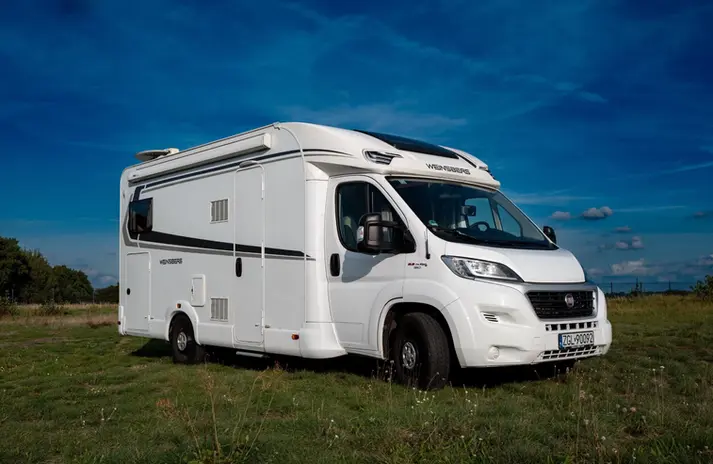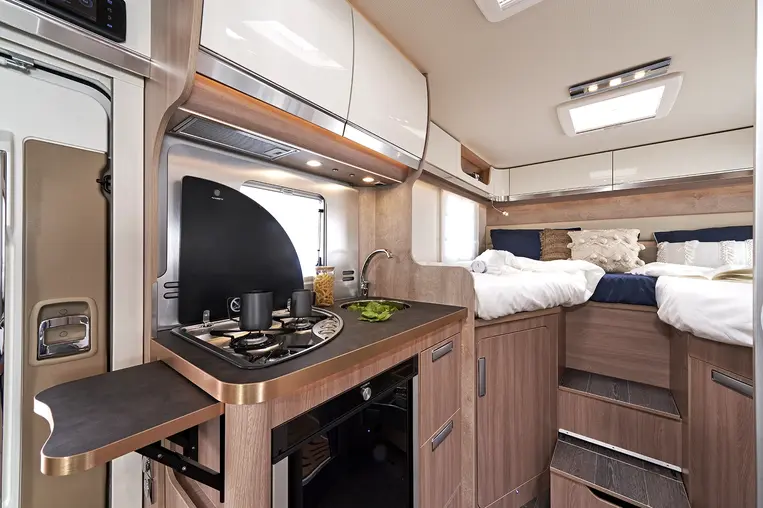
Semi-integra
For families and couples
For 2-4 people, good comfort
Mobility and off-road capability: Low
Semi-Integrated Motorhome – The Classic of Comfort and Functionality in the Camper World
The semi-integrated motorhome is the most recognizable and popular type of camper in Europe. It’s the shape you imagine when you think of a “motorhome” — a sleek silhouette with a distinctively contoured driver’s cab seamlessly joined to the living area.
This type of vehicle offers full travel comfort while maintaining reasonable dimensions and easy handling.
For many, the semi-integrated camper is the perfect balance — it combines space, comfort, and full equipment with the mobility often missing in larger A-class and overcab motorhomes.
Interior – Home Comfort in a Compact Form
The interior of a semi-integrated motorhome is a small but fully functional home.
The layout varies by manufacturer and model, but most vehicles (e.g., Hymer, Bürstner, Adria, Benimar, Dethleffs, Carado) include the following zones:
- Rear bedroom with a double bed (French, central, or twin beds that can be joined into one large bed)
- Bathroom with a full shower, cassette toilet, and sink
- Kitchen area with a 2–3 burner gas stove, sink, large refrigerator (120–150 L), often with freezer and oven
- Living and dining area with a folding table and swivel driver and passenger seats
- Plenty of cabinets, shelves, and storage — including spacious overhead lockers and a rear garage for bicycles, chairs, sports equipment, or luggage
Many semi-integrated models are also equipped with an electric drop-down bed above the cab, allowing up to four people to sleep without converting the lounge.
The interior finish is often of very high quality — LED ambient lighting, warm wood tones, premium fabrics, and soft illumination create an atmosphere that feels like an elegant apartment — only with a view of the mountains, forest, or sea.
Comfort and Everyday Living Onboard
A semi-integrated motorhome provides full living comfort on the road — no matter the weather or the length of your journey.
Thanks to strong thermal insulation and efficient heating (Truma Combi or Alde), you can travel comfortably both in summer in Spain and in winter in the Alps.
Typical equipment includes:
- Warm air heating with a hot water boiler
- Roof ventilation system
- Full LED lighting
- 230V, 12V, and USB sockets
- Side awning
- Mosquito nets and blinds on all windows
- TV with satellite or internet antenna (optional)
- Solar panels and leisure batteries
Unlike campervans, the semi-integrated motorhome gives you space to move around freely inside. You can cook, read, work, or simply relax indoors when it’s raining outside.
Mobility and Driving Experience
Although the semi-integrated is larger than a campervan, it’s still very pleasant to drive — mainly because it’s typically built on a Fiat Ducato, Peugeot Boxer, or Ford Transit chassis.
Diesel engines of 2.0–2.3 liters with 140–180 HP provide plenty of power even for mountain roads.
Most models have front-wheel drive, offering good stability and lower fuel consumption. Higher-end versions come with 9-speed automatic transmissions for added driving comfort.
Average fuel consumption is around 11 L / 100 km — a very reasonable figure for a vehicle 6.5–7.5 meters long.
On the road, a semi-integrated motorhome feels stable, quiet, and well-balanced — the kind of vehicle you can drive 1,000 km a day in without feeling fatigued.
Everyday Use and Independence
The semi-integrated camper is designed for long journeys and complete self-sufficiency.
You can comfortably stay off-grid for several days thanks to:
- A 120–140 L fresh water tank
- A 100 L grey water tank
- A 20 L cassette toilet
- Auxiliary batteries and solar panels
- The option to connect to external power (hook-up)
Some models even feature double floors with extra storage and improved insulation — a solution borrowed from higher-end A-class motorhomes.
Typical Dimensions and Technical Specifications
A semi-integrated motorhome is 6.5–7.5 meters long, 2.25–2.35 meters wide, and 2.85–2.95 meters high.
Interior height is around 1.95–2.05 meters, and the gross vehicle weight (GVW) is 3,500 kg.
Inside, you’ll typically find 2–4 sleeping berths.
Advantages of a Semi-Integrated Motorhome
✅ Full living comfort — bathroom, kitchen, bedroom, and lounge in one
✅ Large garage — fits bicycles, loungers, or sports gear
✅ Excellent insulation and heating — ready for winter travel
✅ Easy to drive — still within the standard Category B license
✅ Perfect balance between space and mobility
Disadvantages of a Semi-Integrated Motorhome
❌ Larger size — harder to park in cities
❌ Not suitable for off-road driving
❌ Higher fuel consumption and maintenance costs than a campervan
❌ More sensitive to crosswinds (due to its height)
Summary
The semi-integrated motorhome is a complete and versatile choice — ideal for couples and families who want to travel in full comfort without needing a huge vehicle.
It provides everything you need: hot water, space, a comfortable bed, a bathroom, and a kitchen — all in a motorhome that’s still easy to maneuver and park.
It’s the perfect choice for those who want to combine adventure with comfort.
You don’t have to give up convenience to enjoy independence — a semi-integrated camper lets you have both.
Who is it for?
- Couples looking for a comfortable, year-round motorhome
- Families (2+2) planning longer trips across Europe
- Travelers who want all the comforts of home — but with a view of the ocean, the mountains, or the fjords.

.png)





